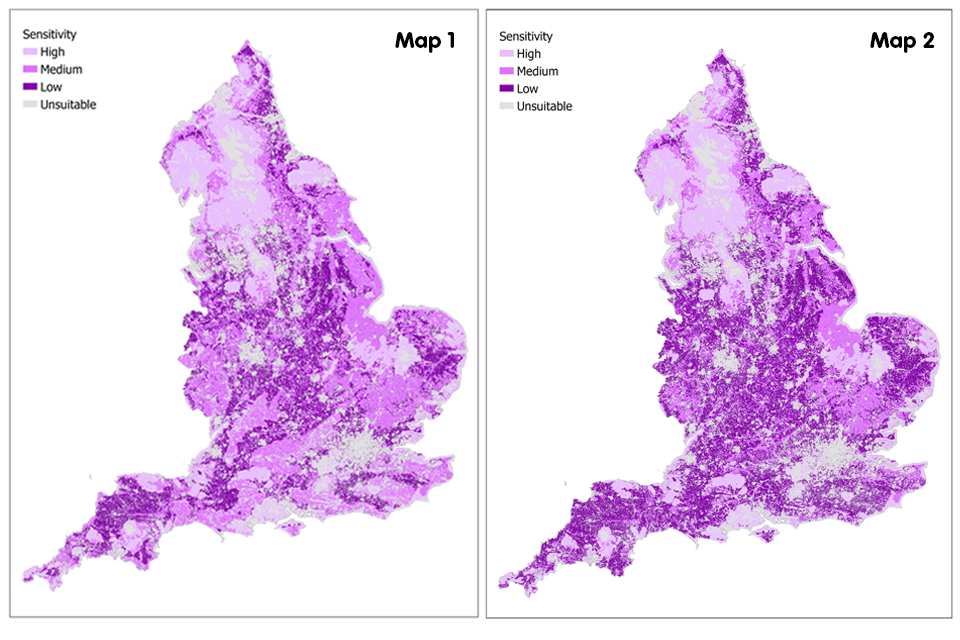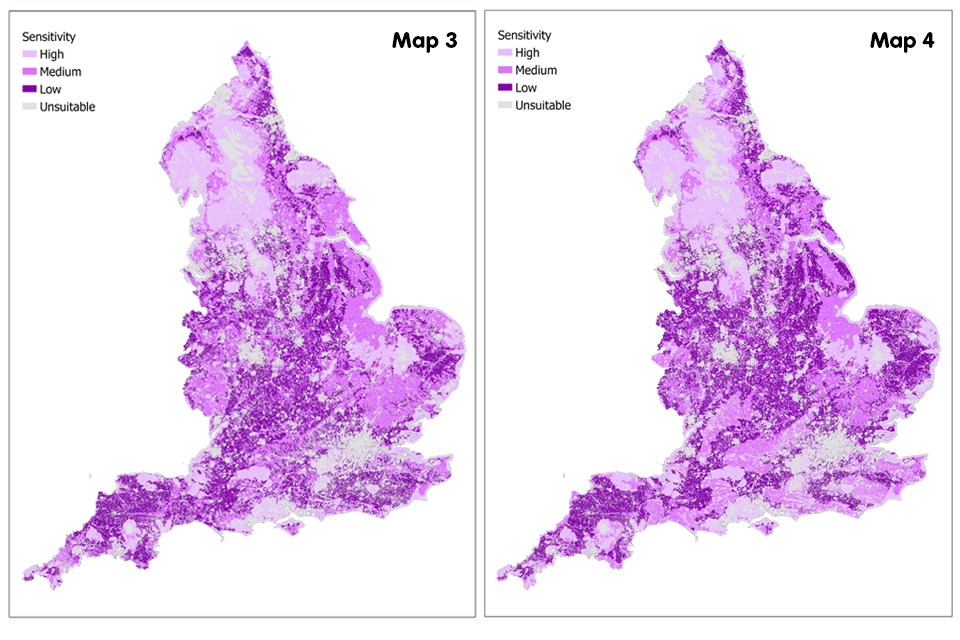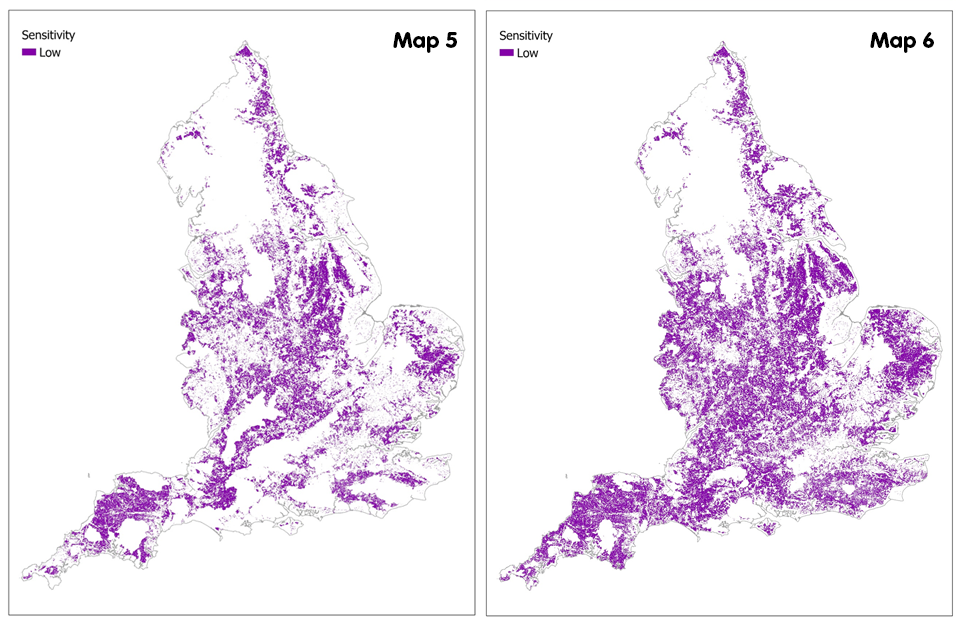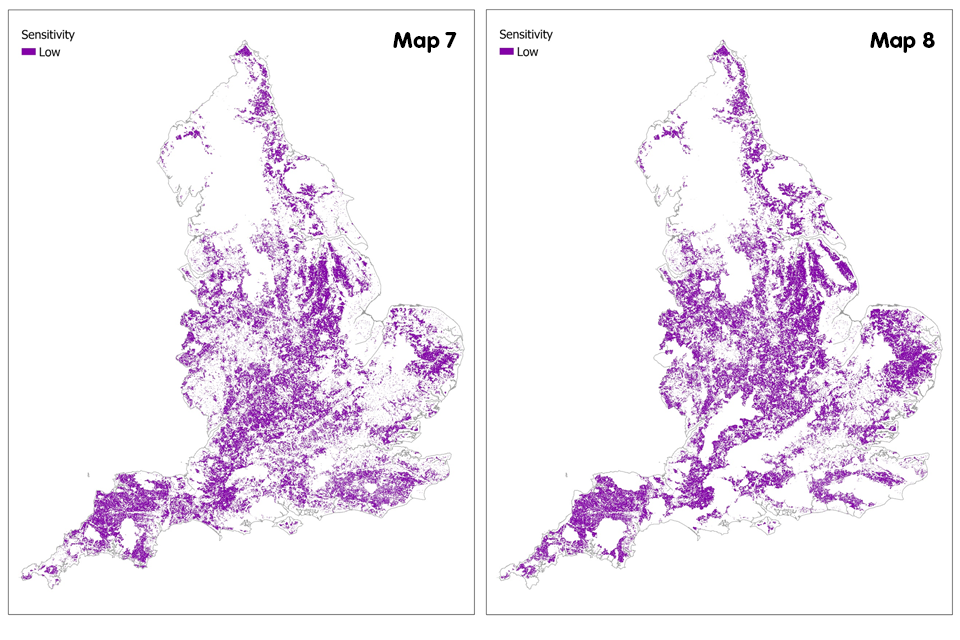A guide to Forestry Commission’s sensitivity maps for woodland creation
Find out about our series of sensitivity maps which indicate where there are likely to be fewer sensitivities to woodland creation in England.
Applies to England
You can view all the sensitivity maps on the Forestry Commission’s map browser, under ‘land sensitivity’.
Sensitivity maps for woodland creation
We have developed a series of sensitivity maps based on nationally available and consistent spatial data. These maps will help to indicate whether there is likely to be potential to establish new woodland on land parcels or where there may be sensitivities that would prevent tree planting or woodland creation.
Where the maps show there is a low sensitivity to woodland creation, this does not guarantee that we will approve planting. However, the low sensitivity areas do not have any clear constraints to address on the basis of national datasets, and it should be easier to agree creating new woodland here than in other areas.
Likewise, creation of new woodland, particularly of native woodland, may be appropriate outside ‘low sensitivity’ areas. We will determine the appropriateness of proposals in these areas. Where relevant, we will respond to the views of Natural England, Environment Agency, Historic England, the local authority and other stakeholders.
The sensitivity maps exclude all land that is unsuitable for planting, for example land mapped as urban areas, existing woodland, assumed woodland, or habitats that are considered too wet, or too rocky or too salty to support the growth of trees. This is achieved by restricting the sensitivity maps to the following land covers, based on the most recent update of Landcover Map (UK Centre for Ecology and Hydrology, 2021):
- acid grassland
- arable and horticulture
- calcareous grassland
- heather
- heather grassland
- improved grassland
- neutral grassland
Variants of the full sensitivity map and low sensitivity map version 4.0
We have also developed 3 variants of the full sensitivity map and associated low sensitivity map, which assign low sensitivity status to either one or both of 2 datasets that are treated as medium sensitivity in the full sensitivity map, as set out below:
England woodland creation low sensitivity map version 4.0 variant 1
- agricultural land class 3a: changed to low sensitivity
- protected landscapes (National Parks and National Landscapes): changed to low sensitivity
England woodland creation low sensitivity map version 4.0 variant 2
- agricultural land class 3a: remaining medium sensitivity
- protected landscapes: changed to low sensitivity
England woodland creation low sensitivity map version 4.0 variant 3
- agricultural land Class 3a: changed to low sensitivity
- protected landscapes: remaining medium sensitivity
The variants of the full and low sensitivity maps have been developed because, in the case of agricultural land quality, the decision to plant on the best and most versatile land is largely an economic decision made by the landowner. Variants 1 and 3 reveal underlying sensitivities of ALC3a land. For protected landscapes, where woodland creation may be desirable, particularly of native woodland, variants 1 and 2 reveal sensitivities to woodland creation other than protected landscape status.
Relationship with the low-risk map for woodland creation
The low sensitivity map v4.0 is a development of the low-risk map for woodland creation, as defined in the Environmental Impact (Forestry) Regulations (2017), with the main differences set out below:
-
all areas of peat included in Natural England’s England peat map are excluded from the low sensitivity map (and its variants), with deep peat classified as high sensitivity and shallow peat and other soils with peaty pockets classified as medium sensitivity
-
areas of land included in the wader zonal maps for curlew and golden plover as strata 2 to 5 are excluded from the low sensitivity map (and its variants), with strata 4 and 5 treated as high sensitivity and strata 2 and 3 as medium sensitivity
-
areas of land included in the wood pasture and Parkland Priority Habitat layer are excluded from the low sensitivity map (and its variants)
-
areas of land included in the historic environment ridge and furrow layer are excluded from the low sensitivity map (and its variants).
-
amended buffers are, in some cases, applied to Sites of Special Scientific Interest (SSSIs), Special Protection Areas (SPAs), Special Areas of Conservation (SACs) and Ramsar sites: details of the buffer that applies to each are set out in the section Summary of the types of Woodland Creation sensitivity maps
-
some layers have also been updated, including the Priority Habitat Inventory
The low-risk map for woodland creation will continue to be used for meeting the requirements of the 2017 EIA (Forestry) regulations in terms of determining where notification may apply, rather than EIA screening. However, the full and the 3 low sensitivity maps represent a more current view of sensitivities to woodland creation.
National breakdown of land sensitivity for woodland creation
National statistics of land sensitivity for the full and low sensitivity maps are given in Table 1, including for the 3 variants.
Table 1. National breakdown of land sensitivity for the England woodland creation full sensitivity map v4.0, the low sensitivity map v4.0 (restricted to blocks more than 2 hectares in area) derived from it, and the 3 variants.
| Sensitivity map | Variant | Sensitivity | Area of England (hectares) |
|---|---|---|---|
| Full sensitivity map v4.0 | None | Unsuitable | 3,314,664 |
| Low | 2,854,532 | ||
| Medium | 3,780,625 | ||
| High | 3,096,414 | ||
| Low sensitivity map v4.0 | Restricted to land parcels more than 2 hectares in size | Low | 2,846,793 |
| Full sensitivity map v4.0, variant 1 | ALC 3a: low sensitivity protected Landscapes: low sensitivity | Unsuitable | 3,314,664 |
| Low | 4,353,194 | ||
| Medium | 2,281,964 | ||
| High 3,096,414 | |||
| Full sensitivity map v4.0, variant 2 | ALC 3a: medium sensitivity protected landscapes: low sensitivity | Unsuitable | 3,314,664 |
| Low | 3,314,664 | ||
| Medium | 3,172,817 | ||
| High | 3,096,414 | ||
| Full sensitivity map v4.0, variant 3 | ALC 3a: low sensitivity protected Landscapes: medium sensitivity | Unsuitable | 3,314,664 |
| Low | 3,620,947 | ||
| Medium | 3,014,211 | ||
| High | 3,096,414 |
Summary of the types of woodland creation sensitivity maps
The datasets now available are:
England woodland creation full sensitivity map v4.0
This dataset is the product of geospatial analysis to identify areas that may have sensitivities that need to be considered when creating new woodland in England. It identifies places regarded as either:
- low sensitivity
- medium sensitivity
- high sensitivity
- unsuitable (for woodland creation)
The full sensitivity map covers all of England to the high-water mark with the entire country assigned to one of the four categories set out above.
England woodland creation low sensitivity map v4.0
This dataset is based on a subset of the ‘England woodland creation full sensitivity map v4.0’ dataset, for England, showing only land regarded as low sensitivity (as in the full sensitivity map), but with the additional criteria that these areas are greater than 2 hectares in extent.
Three variants of the low sensitivity map are also presented:
-
England woodland creation low sensitivity map v4.0 - variant 1
-
England woodland creation low sensitivity map v4.0 - variant 2
-
England woodland creation low sensitivity map v4.0 - variant 3
The low sensitivity map covers all of England to the high-water mark and shows where the land is assigned as low sensitivity according to the respective criteria for the specific map as fully detailed below.
Woodland Creation Opportunity Area
Any land that falls under the following land classifications in the UK Centre for Ecology & Hydrology (UKCEH) Land Cover Map 2020 (25 m raster):
| Type | Land classification identifier |
|---|---|
| Acid grassland | 7 |
| Arable and horticulture | 3 |
| Calcareous grassland | 6 |
| Heather | 9 |
| Heather grassland | 10 |
| Improved grassland | 4 |
| Neutral grassland | 5 |
The following non-woodland components of the National Forest Inventory are also included:
- agriculture land
- bare ground
- grassland
- low density tree cover
- other vegetation
- shrub
How land is classified unsuitable or low, medium, high sensitivity
Extent: England
Format: Raster grid, polygon format also available
Grid resolution: 25 metres by 25 metres
Land that is low sensitivity for woodland creation
Land with a low sensitivity for woodland creation is defined in this map layer as land with any one or more of the following designations:
It is not:
- unsuitable
- high sensitivity for woodland creation
- medium sensitivity for woodland creation
It is within land from the following land cover categories of the Land Cover Map (2021) (LCM) published by the UK Centre for Ecology & Hydrology (UKCEH):
- acid grassland
- arable and horticulture
- calcareous grassland
- heather
- heather grassland
- improved grassland
- neutral grassland
The following non-woodland Interpreted Forest Types (IFTs) from Forest Research’s National Forest Inventory (NFI) woodland map (2020) are also included:
- agriculture land
- bare ground
- grassland
- low density tree cover
- other vegetation
- shrub
Land that is medium sensitivity for woodland creation
Land with a medium sensitivity for new planting of woodland is defined in this map layer as land with any one or more of the following designations:
It is not:
- unsuitable
- high sensitivity for woodland creation
It is in map layers defined as:
-
acid vulnerable catchments: catchments are assessed for acid vulnerability using the Water Framework Directive classification of water quality, published by the Environment Agency. We define acid vulnerability from the results for pH (one element of the Physico-Chemical Quality test) and both fish and invertebrates, which are elements of the biological quality test (i.e. all areas defined as ‘FAIL’, or ‘FAIL_BIO’ in the 2019 data)
- Agricultural Land Class (ALC): In areas ALC 1, or ALC 2 or ALC 3a
- National Landscapes, previously known as Areas of Outstanding Natural Beauty (AONBs)
- Birdlife International Important Bird Areas (IBAs)
- Countryside Stewardship (CS): a) Land parcels with CS scheme agreements with end dates later than 31 December 2021; plus b) Land parcels in all Higher-tier agreements
- Countryside Right of Way (CROW) Act 2000 - S4 Conclusive Registered Common Land
- Environmental Stewardship Higher Level Agreements
- Local Nature Reserves (LNRs)
- National Parks (NPs)
- Natural England peat map: on land with either shallow peaty soils = medium sensitivity and other soils with peaty pockets = medium sensitivity
- Priority Habitat Inventory: in places that are any one or more of the following: fragmented heath, grass moorland, good quality semi-improved grassland
- Wader Zonal Map for golden plover and curlew breeding wading bird species (a combined layer showing highest sensitivity for either species): In either strata 2 or strata 3 areas (i.e. medium sensitivity)
- ridge and furrow: ridge and furrow with no buffer applied: detection areas only
Land that is high sensitivity for woodland creation
Land with a high sensitivity for new planting of woodland is defined in this map layer as land within any one or more of the following designations:
It is not unsuitable. It is within:
- National Nature Reserves
- Natural England peat map: in areas of deep peaty soils
- Priority Habitat Inventory: within other than fragmented heath, grass moorland, and good quality semi-improved grassland
- Ramsar sites: in, or within a 700 metre buffer
- registered battlefields: in, or within a 200 metre buffer
- registered parks and gardens: in, or within a 200 metre buffer
- scheduled monuments: in, or within a 200 metre buffer
- Special Protection Areas (SPAs): in, or within a 2,000 metre buffer
- Sites of Special Scientific Interest (SSSIs): if the land is above the moorland line, then in, or within a 1,000 metre buffer
- Sites of Special Scientific Interest (SSSIs): if the land is below the moorland line, then in, or within a 250 metre buffer
- Special Areas of Conservation (SACs): if the land is above the moorland line, then in, or within a 700 metre buffer
- Special Areas of Conservation (SACs): if the land is below the moorland line, then in, or within a 250 metre buffer
- Wader Zonal Map for golden plover and curlew breeding wading bird species (a combined layer showing highest sensitivity for either species): in either strata 4 or strata 5 areas (i.e. high sensitivity)
- World Heritage Site: in, or within a 200 metre buffer
- wood pasture and parkland priority habitat: all categories
Land that is unsuitable for woodland creation
Land that is unsuitable for new planting of woodland is defined in this map layer as land with any one or more of the following designations:
Land Cover Map (2021) (LCM) from the UK Centre for Ecology & Hydrology (UKCEH): In places defined as:
| Type | Land classification identifier |
|---|---|
| Bog | 11 |
| Coniferous woodland | 2 |
| Deciduous woodland | 1 |
| Fen | 8 |
| Freshwater | 14 |
| Inland rock | 12 |
| Littoral rock | 17 |
| Littoral sediment | 18 |
| Saltmarsh | 19 |
| Saltwater | 13 |
| Suburban | 21 |
| Supralittoral rock | 15 |
| Supralittoral sediment | 16 |
| Urban | 20 |
National Forest Inventory (NFI) woodland map (2020) from Forest Research. The following Interpreted Forest Types (IFTs):
- assumed woodland
- broadleaved
- conifer
- coppice
- coppice with standards
- failed
- felled
- ground prep
- mixed mainly broadleaved
- mixed mainly conifer
- open water
- quarry
- river
- road
- uncertain
- urban
- windblown
- young trees
All areas of England not thus defined as ‘unsuitable’ have gone on to be identified as either low sensitivity, medium sensitivity, or high sensitivity.
The England woodland creation low sensitivity map v4.0
Extent: England
Format: Raster grid, polygon format also available
Grid resolution: 25 m by 25 m
This is a separate geospatial map layer based on a subset of the England woodland creation full sensitivity map v4.0.
It shows land parcels that fulfil both of the following criteria:
- low sensitivity for woodland creation in the England woodland creation full sensitivity map v4.0
- of an extent of 2 hectares or more
The England woodland creation low sensitivity map v4.0: further 3 variants
Extent: England
Format: Raster grid, polygon format also available
Grid resolution: 25 m by 25 m
Of an extent of 2 hectares or more
These are 3, further, separate geospatial map layers based on the England woodland creation low sensitivity map v4.0:
England woodland creation low sensitivity map v4.0 - variant 1
This is the England woodland creation low sensitivity map v4.0 plus areas of land that have different sensitivities assigned compared to the core England woodland creation low sensitivity map v4.0:
- Agricultural Land Classification 3a assigned as low sensitivity
- National Landscapes assigned as low sensitivity
- National Parks assigned as low sensitivity
England woodland creation low sensitivity map v4.0 - variant 2
This is the England woodland creation low sensitivity map v4.0 plus areas of land that have different sensitivities assigned compared to the core England woodland creation low sensitivity map v4.0:
- National Landscapes assigned as low sensitivity
- National Parks assigned as low sensitivity
England woodland creation low sensitivity map v4.0 - variant 3
This is the England woodland creation low sensitivity map v4.0 plus areas of land that have different sensitivities assigned compared to the core England woodland creation low sensitivity map v4.0: Agricultural Land Classification 3a assigned as low sensitivity.
Spatial datasets used in sensitivity mapping
| Dataset | Date |
|---|---|
| Acid vulnerable catchments (see item 1) | 19 September 2023 |
| Agricultural Land Classification (ALC) (see item 2) | 12 March 2019 |
| Areas of Outstanding Natural Beauty (AONBs) | 15 May 2020 |
| Birdlife International Important Bird Areas (see item 3) | February 2020 |
| Countryside Stewardship (CS) | 25 September 2023 |
| CROW Act 2000 - S4 Conclusive Registered Common Land | 24 October 2017 |
| Environmental Stewardship Higher Level Scheme Agreements | 3 October 2023 |
| UKCEH Land Cover Map (2021) (LCM)(see item 4) | 4 May 2023 |
| Local Nature Reserves (LNRs) | 15 February 2022 |
| National Forest Inventory (NFI) woodland map (2020) | 28 July 2022 |
| National Nature Reserves | 15 March 2022 |
| National Parks (NPs) | 15 February 2019 |
| Natural England Peat Map (see item 5) | 22 July 2021 |
| Priority Habitat Inventory | 26 July 2023 |
| Ramsar sites | 15 September 2020 |
| Registered Battlefields | 20 August 2021 |
| Registered parks and gardens | 4 January 2022 |
| Scheduled monuments | 24 February 2022 |
| Sites of Special Scientific Interest (SSSIs) | 15 March 2022 |
| Special Areas of Conservation (SAC) | 7 December 2021 |
| Special Protection Areas (SPAs) | 7 December 2021 |
| Wader Zonal Map | 18 December 2021 |
| World Heritage Sites | 20 August 2021 |
| Wood Pasture and Parkland Priority Habitat | 21 October 2020 |
| Ridge and furrow (see item 6) | 14 August 2023 |
Item 1: the Acid Vulnerable Catchments layer
Waterbodies that have failed for pH (low pH - acidic) and/or biology due to acidification are treated as failing and their catchments are flagged by failing in the column ‘RBMP_c3’. The mapping will be updated for each cycle of the River Basin Management Plans. The ‘At Risk’ category has been removed as there is enough evidence to determine if the catchment is vulnerable (failing) or not.
Item 2: provisional Agricultural Land Classification (ALC)
Agricultural Land Classification data that have been further refined using the ‘Likelihood of Best and Most Versatile’ (BMV) layer to split class 3 land into 3a and 3b. For BMV Licence information contact data.services@naturalengland.org.uk. © Natural England copyright [2019], reproduced with the permission of Natural England. © Crown Copyright and database right. Ordnance Survey licence number AC0000851168. Derived from 1:50 000 scale BGS Digital Data under Licence 2006/072 British Geological Survey. © NERC. National Soils map . © Cranfield University (NSRI) . © Crown Copyright and database rights
Item 3: Important Bird Areas (IBA)
Data reproduced with the permission of RSPB. © Crown Copyright. Ordnance Survey licence number 100021787 (2022).
Item 4: UKCEH Land Cover Map
UK Centre for Ecology & Hydrology’s Land Cover Maps are parcel-based thematic classifications of satellite image data covering the UK. They are used in a wide range of applications by government departments and agencies, county councils, charities and environmental management bodies.
Further details of the land cover map used for the woodland creation sensitivity maps can be found in: Morton RD; Marston CG; O’Neil AW and Rowland CS (2021). Land Cover Map 2020 (land parcels, GB) NERC EDS Environmental Information Data Centre.
Item 5: Natural England peat map
Find peaty soils location data for more information on this data layer and licensing. By using this data you are accepting the terms of use of a 3rd party supplier. You will be provided with the relevant terms of use. BGS, Cranfield University and OS must be acknowledged in any reports or documents produced as a result of using the peat layer.
Item 6: Ridge and Furrow
This dataset is subject to restrictions. It can only be used internally by Forest Services and for inclusion in sensitivity and opportunity mapping where the data is aggregated with other large-scale datasets.
National overview of the full sensitivity map version 4.0
Map 1: England woodland creation full sensitivity map version 4.0
Map 2: England woodland creation full sensitivity map version 4.0 variant 1

Map 1 and map 2: these maps of England show the different levels of sensitivity by coloured shading. The darkest shading is 'low sensitivity' and the lightest is 'unsuitable' © Crown copyright
Map 3: England woodland creation full sensitivity map version 4.0 variant 2
Map 4: England woodland creation full sensitivity map version 4.0 variant 3

Map 3 and map 4: these maps of England show the different levels of sensitivity by coloured shading. The darkest shading is 'low sensitivity' and the lightest is 'unsuitable' © Crown copyright
Map 5: England woodland creation low sensitivity map version 4.0
Map 6: England woodland creation low sensitivity map version 4.0 variant 1

Map 5 and map 6: these 2 maps show areas of low sensitivity in England by coloured shading. Map 6 (variant 1) shows slightly more low sensitivity areas © Crown copyright
Map 7: England woodland creation low sensitivity map version 4.0 variant 2
Map 8: England woodland creation low sensitivity map version 4.0 variant 3

Map 7 and map 8: these 2 maps show areas of low sensitivity in England by coloured shading © Crown copyright
Further information
For further information on any of these woodland creation sensitivity map geospatial data layers you can contact evidence@forestrycommission.gov.uk.
Version 4.0 represents the most up to date mapping of known sensitivities to woodland creation. You can also view this guide in PDF format:
You can read the (Version 3.0).
Updates to this page
-
Updated the guide to reflect version 4.0 of our sensitivity maps for woodland creation. This version represents the most up to date mapping of known sensitivities to woodland creation.
-
First published.